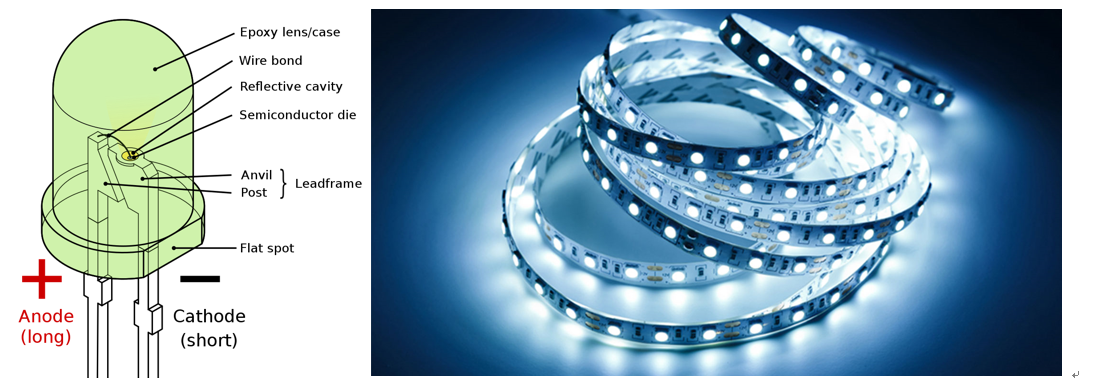LEDs are widely used and commonly seen in various aspects of daily life such as offices, malls, parks, cars, signal lights, billboards, and more. But do you know why LEDs are chosen over traditional incandescent and fluorescent lights, and what advantages they offer?
This article will provide a detailed comparison between LEDs and ordinary lights, as well as methods to identify LED products, helping you make informed decisions when selecting lighting fixtures.
LEDs, or light-emitting diodes, are semiconductor devices that emit light when a current passes through them. They utilize solid-state semiconductor chips as light-emitting materials. When a forward voltage is applied across the ends, carriers in the semiconductor recombine, causing photon emission and generating light. LEDs can emit light in various colors such as red, yellow, blue, green, cyan, orange, purple, and white.
Due to the sensitivity of LEDs to current, even tiny currents can make them emit light. They also have a long lifespan and can flicker for extended periods without damage, making them energy-efficient and highly effective light sources. LEDs, as a new lighting technology, have distinct differences and unique features compared to traditional lighting fixtures.
Comparison: LED vs. Traditional Lights
| Aspect | LED | Traditional Lights |
|---|---|---|
| Energy Efficiency | High | Low |
| Lifespan | Over 10,000 hours | Around a few thousand hours |
| Light Quality | No heat or radiation/Uniform/Near-natural light | Heat and radiation present/Uneven/Easily produces color deviation |
| Environmental Characteristics | Contains no harmful substances, non-polluting | Contains harmful substances, prone to environmental pollution |
| Shock Resistance | Good | Average |
| Color Rendering Index | Wide | Narrow |
| Price | Expensive | Cheap |
When purchasing lighting fixtures, how can you identify LED products? By observing the following characteristics of LED lights, you can make an informed choice:
Firstly, LED lights typically have the label “LED” clearly marked on the product packaging. You can carefully inspect the exterior packaging of the light fixture.
Secondly, you can distinguish them by their appearance. LED lights are usually compact, with larger ones composed of LED cells. Inside the bulb, LED chips or solid-state materials may be visible. The smallest LEDs are only on the order of square millimeters or smaller, while traditional incandescent bulbs have visible filaments.
You can also identify LED lights by their light characteristics. LED lights generally produce brighter and more uniform light without noticeable flickering or dimming.
As mentioned earlier, LED lights typically have lower energy consumption than traditional lights. Therefore, you can also identify them by checking the product’s energy consumption information, usually expressed in watts (W) or luminous efficiency (lumens per watt).
Some LED lights may have obtained environmental certifications such as CCC, CE, or FCC, which can also serve as distinguishing factors.
LED lights differ significantly from traditional incandescent and fluorescent lights in terms of energy efficiency, lifespan, light quality, and environmental impact. By observing the appearance, checking labels and packaging, examining light characteristics, understanding energy consumption information, and environmental certifications, you can effectively distinguish LED lights. In the future of lighting, LEDs will continue to play a vital role and contribute even more to energy efficiency and environmental protection.



